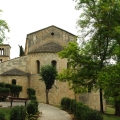The National Shrine of Our Lady of Mellieħa is one of Malta’s oldest and most venerated pilgrimage sites, home to a sacred Marian icon of Sicilian-Byzantine origin, traditionally attributed to St. Luke the Evangelist during his stay on the island in AD 60. Although the existing painting likely dates from the 13th century, written records mention the site’s consecration as a church as early as the 5th century.
Over the centuries, thousands of pilgrims have visited to pray before the Virgin and Child, seeking miracles and protection, as shown by the numerous ex-voto offerings. Despite enduring pirate attacks (notably in 1614) and environmental damage, devotion to Our Lady never waned. A meticulous restoration in 2013 unveiled precious original features, including the inscription “MAT DEI” (Mother of God) and Byzantine symbols such as the cross within Christ’s halo.
The sanctuary also includes a grotto chapel, carved into the rock in 1644 by Sicilian wine merchant Mario de Vasi, featuring a white statue of Our Lady. The grotto has become renowned for reported miraculous phenomena, including movements of the Virgin’s hand and blessings from the Christ Child, witnessed by priests and laypeople in the 19th and 20th centuries.
Today, the shrine is part of the European Marian Network and was officially designated Malta’s National Marian Shrine in 2015. It remains a deeply spiritual site where devotion, history, and legend converge to honor the Theotokos—Mother of God.
- Address
X966+4GM, Triq l-Erwieħ, Il-Mellieħa, Malta - Web
https://geo.io/en/Sanctuary_of_Our_Lady_of_Mellie%C4%A7a - Visiting Hours
Everyday from 8:00 to 18:00 - What to see
Image of Our Lady of Mellieħa




